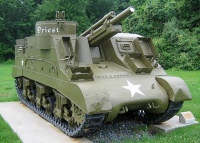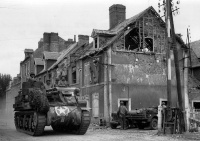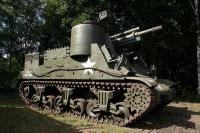M7 Priest
| Revision as of 22:56, 17 February 2013 | Revision as of 00:57, 26 May 2013 | |||
| Line 1: | Line 1: | |||
| {{TankData | {{TankData | |||
| ? | + | The Priest has good reload time for an SPG, at the cost of being somewhat inaccurate and having poor splash damage - should it miss, it will not deal significant damage to close targets. Also, hitting high tier enemies with the regular HE shell will almost always ping them for a meager amount of damage, which can be frustrating at times. Unfortunately, the alpha doesn't compare with the Grille at it's same tier, and the SU-5 has a higher rate of fire and a higher penetrating gun, but the Priest does have a large ammo capacity. | ||
| ? | + | |||
| ? | The Priest has good reload time for an SPG, at the cost of being somewhat inaccurate and having poor splash damage - should it miss, it will not deal significant damage to close targets. Also, hitting high tier enemies with the regular HE shell will almost always ping them for a meager amount of damage, which can be frustrating at times. | + | ||
| Line 9: | Line 7: | |||
| * Very good engine power and top speed | * Very good engine power and top speed | |||
| * Good gun arc and elevation arc | * Good gun arc and elevation arc | |||
| ? | * | + | * Decent rate of fire high and ammo capacity | |
| * Great view and signal range | * Great view and signal range | |||
| * Very wide gun traverse | * Very wide gun traverse | |||
| Line 18: | Line 16: | |||
| * Not really accurate | * Not really accurate | |||
| * Bad splash damage | * Bad splash damage | |||
| + | * Rather low damage values, not an upgrade from the previous M37 | |||
| |InTheGame_performance= | |InTheGame_performance= | |||
Revision as of 00:57, 26 May 2013
{{TankData The Priest has good reload time for an SPG, at the cost of being somewhat inaccurate and having poor splash damage - should it miss, it will not deal significant damage to close targets. Also, hitting high tier enemies with the regular HE shell will almost always ping them for a meager amount of damage, which can be frustrating at times. Unfortunately, the alpha doesn't compare with the Grille at it's same tier, and the SU-5 has a higher rate of fire and a higher penetrating gun, but the Priest does have a large ammo capacity.
|InTheGame_pros=
- 106mm thick lower hull front plate.
- Very good engine power and top speed
- Good gun arc and elevation arc
- Decent rate of fire high and ammo capacity
- Great view and signal range
- Very wide gun traverse
|InTheGame_cons=
- Very poor hull traverse speed
- Worthless armor everywhere but on the lower hull front.
- Not really accurate
- Bad splash damage
- Rather low damage values, not an upgrade from the previous M37
|InTheGame_performance= You cannot mount the upgraded gun without increasing your weight limit, so the suspension should probably be your first purchase. In fact, you can't even equip a Camouflage Net without upgrading the suspension. Combined with the limited range of the stock cannon, this can make the first few battles particularly hazardous. Once you get the upgraded gun, however, the range becomes excellent. The armor on the sides and rear is useless, even the sloped upper front armor rarely bounces Tier 1 guns. However, perhaps this is because the Priest model used in the game was based on a unit built upon the chassis of a "Jumbo", perhaps because of a joke in the developer team related to the name of the vehicle, but the lower part of the Priest's front has an armor thickness that won't be seen again until the upgraded turret of the KV-1 Soviet heavy tank.
|InTheGame_research=
- The SCR 506 radio carries over from the M37. If you played the M4 Sherman before this, then the Wright Continental R-975C4 engine will also be available to you.
- The upgraded suspension is an immediate necessity. Make it your first research project.
- Research the 105 mm Howitzer M2A1 for much greater range.
- Go from there.
|InTheGame_equipment= Artillery Shell Rammer, GLD, Camouflage Net
|Gallery= image:M7_Priest_001.jpg|M7_Priest_001 image:M7_Priest_002.jpg|M7_Priest_002 image:M7_Priest_003.jpg|M7_Priest_003 image:M7_Priest_004.jpg|M7_Priest_004
|History=
The 105 mm Howitzer Motor Carriage M7 was an American self-propelled artillery vehicle produced during World War II. It was given the official service name 105 mm Self Propelled Gun, Priest by the British Army, due to the pulpit-like machine gun ring, following on from the Bishop and the contemporary Deacon self-propelled guns.
History
Witnessing the events of the war, U.S. Army observers realized that they would need a self-propelled artillery vehicle with sufficient firepower to support armored operations. Lessons learned with half-tracks (such as the T19) also showed that this vehicle would have to be armored and fully tracked. It was decided to use the M3 Lee chassis as the basis for this new vehicle design, which was designated T32.
After reworking the M3 by providing an open-topped superstructure, mounting a 105 mm howitzer and, following trials, adding a machine gun, the T32 was accepted for service as the M7 in February 1942 and production began that April.
While the first M7s were produced for the U.S. Army, supply was soon diverted to support the Lend-Lease program. Ninety M7s were sent to the British 8th Army in North Africa, who were also the first to use it in battle during the Second Battle of El Alamein as well as their own Bishop: a 25-pounder, howitzer-armed self-propelled gun. The M7 soon proved successful and the British requested 5,500 of them: an order which was never fully completed. They did find problems with the M7 though, as the primary armament was of U.S., not British standard. This meant that the M7s had to be supplied separately, causing logistical complications. It was a problem that was only truly resolved in 1943 on arrival of the 25-pounder-armed Sexton developed by the Canadians on a similar chassis. Until that time though, the British continued to use the M7 throughout the North African Campaign, the Italian Campaign, and even a few during the early days of the Normandy Invasion. After the Sexton appeared, most British M7s were converted into "Kangaroo" armored personnel carriers.
In U.S. service, the M7 was a great success. Each U.S. armored division had three battalions of M7s, giving them unparalleled mobile artillery support.
A total of 3,490 M7s were built, and they proved to be reliable weapons, continuing to see service in the U.S. and allied armies well past World War II.
Variants
- M7 --The first M7s produced were modified M3 Lee medium tanks. In order to maintain a low silhouette, the howitzer elevation had to be restricted to 35°. In May 1942, after only a month of production, the vehicle was altered to increase it's ammunition storage from 24 to 69 rounds. This was achieved by placing seven rounds on the left wall, five on the right, and storing the remainder under floor plates. The M7 also went through a fairly rapid shift from being based on the M3, to having more commonality with the M4 Sherman. The first major example was an adoption of the M4's three-piece housing, single piece casting, and suspension. In British service, some M7s carried a radio set, which took the place of 24 rounds of ammunition.
- M7B1 -- Completing the shift, the M7B1 was fully based on the M4A3 Sherman chassis. It was standardized in September 1943, and declared the "substitute" standard in January 1945.
- M7B2 --During the Korean War, the limited elevation of the howitzer became noticeably problematic and it was increased to 65° to increase the effective range of the howitzer. The machine gun mount also had to be raised to give a 360° firing arc.
- Defrocked Priest -- As one part of the Allied effort to capture Caen and breakout from the Normandy beaches, several M7s had their main gun removed in the field for use as armored personnel carriers and were used in Operation Goodwood. These field modified vehicles were referred to as "Defrocked Priests."
- Kangaroo -- A Canadian armored personnel carrier (APC) conversion of the M7 for use by British and Commonwealth units in northern Europe. The Kangaroo could carry 20 infantry plus a crew of two. A total of 102 were converted between October 1944 and April 1945. The name "Kangaroo" became generic for all APC conversions of armored fighting vehicles no longer suitable for combat, including Ram conversions.
|HistoricalGallery=
File:M7b2priest_german.jpg
image:M7_Priest_korea.jpg|Howitzer Motor Carriage M7 in Korea (1951)
|Ref_references=
|Ref_sources=
|Ref_links=
}}


